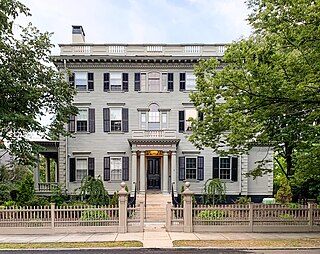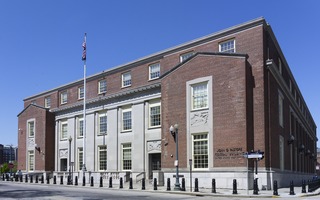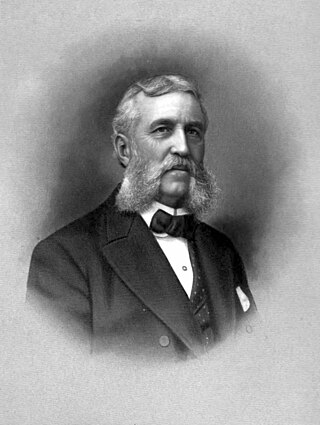
The PSFS Building, now known as the Loews Philadelphia Hotel, is a skyscraper which is located in Center City, Philadelphia, Pennsylvania. A National Historic Landmark, the building was the first International style skyscraper constructed in the United States.

The Westminster Arcade is a historic shopping center at 130 Westminster Street and 65 Weybosset Street in downtown Providence, Rhode Island built in 1828. It is notable as the first enclosed shopping mall in the United States and has been lauded as a fine example of commercial Greek Revival architecture. It served as a shopping center for many years before falling into decline in the late 20th century. It has since been closed for renovation and rehabilitation several times, and most recently reopened its doors in October 2013 as a residential and commercial mixed-use building. It was declared a National Historic Landmark in 1976.
AS220 is a non-profit community arts center located in Downtown, Providence, Rhode Island, United States. AS220 maintains four dozen artist live/work studios, around a dozen individual work studios, six rotating exhibition spaces, a main stage, a black box theater, a dance studio, a print shop, a community darkroom, a digital media lab, a fabrication lab, an organization-run bar and restaurant, a youth recording studio, and a youth program. AS220 is an unjuried and uncensored forum for the arts, open to all ages.

College Hill is a historic neighborhood of Providence, Rhode Island, and one of six neighborhoods comprising the city's East Side. It is roughly bounded by South and North Main Street to the west, Power Street to the south, Governor Street and Arlington Avenue to the east and Olney Street to the north. The neighborhood's primary commercial area extends along Thayer Street, a strip frequented by students in the Providence area.

The Governor Henry Lippitt House is a historic house museum at 199 Hope Street on the East Side of Providence, Rhode Island. A National Historic Landmark, it is one of the finest Italianate mansion houses in the state, and considered one of the best-preserved examples of Victorian-era houses in the United States. It is notable for its association with Henry Lippitt (1818–91), a wealthy textile magnate who was the 33rd Governor of Rhode Island. The house is owned by Preserve Rhode Island, and is open to the public for tours seasonally or by appointment.

Stone, Carpenter & Willson was a Providence, Rhode Island based architectural firm in the late 19th and early 20th Centuries. It was named for the partners Alfred Stone (1834–1908), Charles E. Carpenter (1845–1923). and Edmund R. Willson (1856–1906). The firm was one of the state's most prominent.

Thaw Hall is a historic academic building on the campus of the University of Pittsburgh that is a contributing property to the Schenley Farms National Historic District and has been named a Pittsburgh History and Landmarks Foundation Historic Landmark. The five-story building of stone, brick, and terra cotta was completed in 1910 in the Neoclassical Beaux-Arts style by architect Henry Hornbostel and today serves as space for a variety of academic classrooms, labs, offices, and centers. It is located between, and connected to, the university's Old Engineering Hall and Space Research Coordination Center (SRCC) along O'Hara Street in the Oakland neighborhood of Pittsburgh.

The Nelson W. Aldrich House, also known as the Dr. S. B. Tobey House, is a Federal-style house at 110 Benevolent Street in the College Hill neighborhood of Providence, Rhode Island. The house was the home of Nelson W. Aldrich, a U.S. Senator from 1881 to 1911. Aldrich was a dominant and controversial figure in the Senate, exercising significant control over the legislative process. This house, one of two surviving properties associated with Aldrich, was declared a National Historic Landmark in 1976. It is now a house museum operated by the Rhode Island Historical Society.

The John Brown House borders the campus of Brown University at 52 Power Street on College Hill in Providence, Rhode Island. Completed in 1788, it was the first mansion to be built in Providence and is named after its first owner, John Brown, a statesman, merchant, slave trader, and early benefactor of the University.

The Nightingale–Brown House is a historic house at 357 Benefit Street on College Hill in Providence, Rhode Island. It is home to the John Nicholas Brown Center for Public Humanities and Cultural Heritage at Brown University. The house is architecturally significant as one of the largest surviving wood-frame houses of the 18th century, and is historically significant as the longtime seat of the Brown family, whose members have been leaders of the Providence civic, social, and business community since the 17th century, and include nationally significant leaders of America's industrialization in the 19th century. The house was listed on the National Register of Historic Places and declared a National Historic Landmark in 1989.

Sydney Richmond Burleigh was an American artist, known primarily for his watercolors but also for his oil paintings, drawings, illustrations, and building and furniture designs.

The Telephone Building is a historic commercial building at 112 Union Street in downtown Providence, Rhode Island. It was built as the headquarters and exchange of the Providence Telephone Company, which occupied it from 1893 to 1917.

The Union Trust Company Building is a historic building at 170 Westminster Street and 62 Dorrance Street in downtown Providence, Rhode Island.

Riversdale, is a five-part, large-scale late Georgian mansion with superior Federal interior, built between 1801 and 1807. Also known as Baltimore House, Calvert Mansion or Riversdale Mansion, it is located at 4811 Riverdale Road in Riverdale Park, Maryland, and is open to the public as a museum.

The John O. Pastore Federal Building is a courthouse of the United States District Court for the District of Rhode Island located in Providence, Rhode Island. The building also houses a post office.

The Fisk Barn is a historic barn on Gerry Road in Dublin, New Hampshire, United States. Built in the 1790s, it is a good local example of 18th-century farm architecture, made further notable by its conversion to an art studio in 1929, during Dublin's heyday as an artists' colony. The barn was listed on the National Register of Historic Places in 1983.

The Providence Art Club, Thomas Street, Providence, Rhode Island, was founded in 1880. An art club is an organization for artists and the community to engage and collaborate with each other in a shared space dedicated to art and culture. The Providence Art Club has studios, galleries, eateries, and a clubhouse in a "picturesque procession of historic houses," which are across the street from the First Baptist Church in America.[1] The buildings occupied by the Providence Art Club include Brick House, the two Seril Dodge Houses at 10 and 11 Thomas Street, Deacon Taylor House, and Fleur De Lys Studio.

Edward I. Nickerson (1845–1908) was an American architect from Providence, Rhode Island, known for his work in the Queen Anne style in Providence.

George William Whitaker was a prominent Rhode Island landscape painter during the late 19th and early 20th century, known as the "Dean of Providence painters" or the "Dean of Rhode Island Artists."
Angela O'Leary (1879–1921) was a Rhode Island artist and model. O'Leary studied at the Rhode Island School of Design; she took classes with Sydney Richmond Burleigh and became a member of the Providence Art Club and the Providence Watercolor Club. O'Leary often painted landscapes and genre scenes. She died after attempting to commit suicide in the Fleur-de-lys Studios. The Providence Art Club held a memorial exhibition in her honor after her death.





















